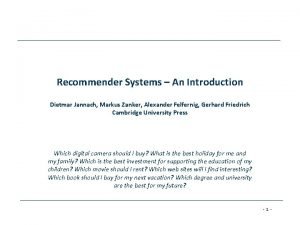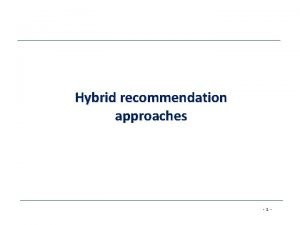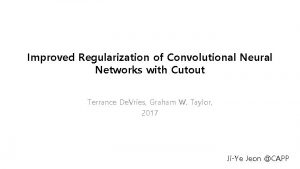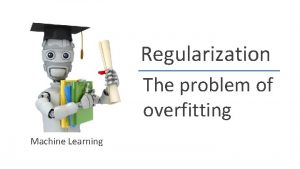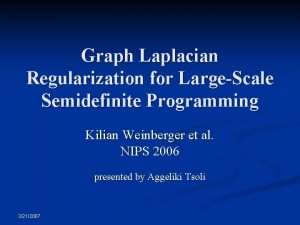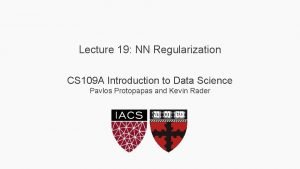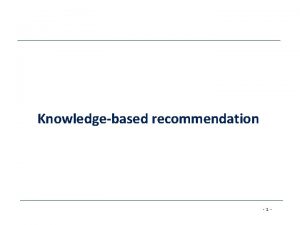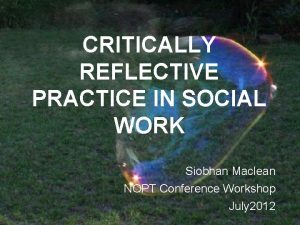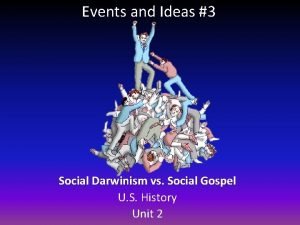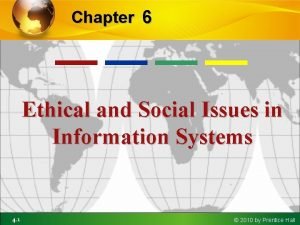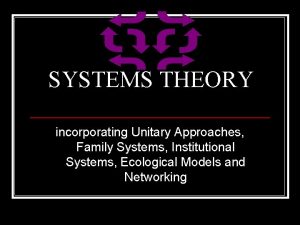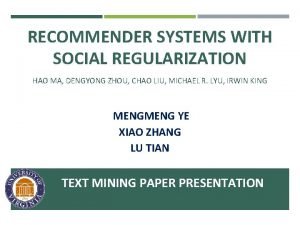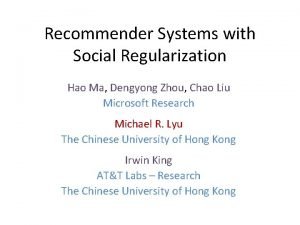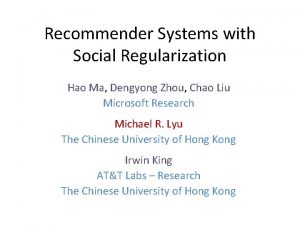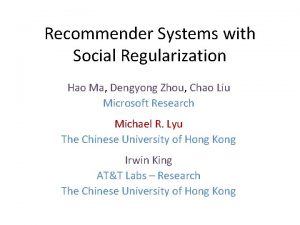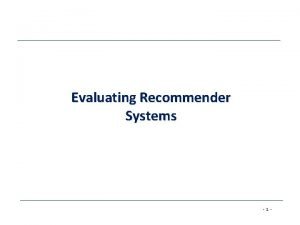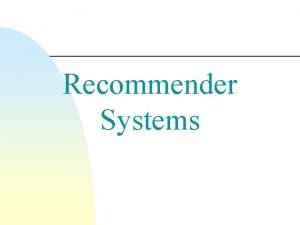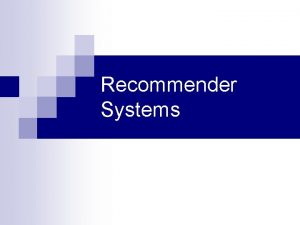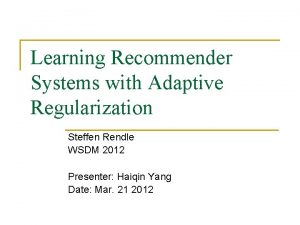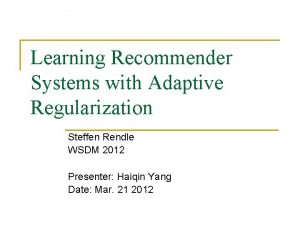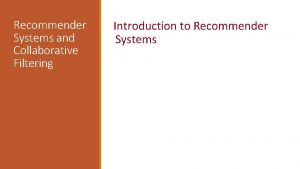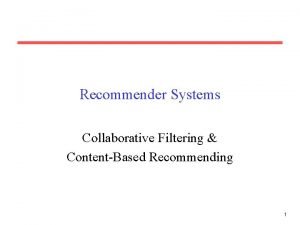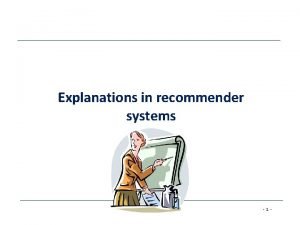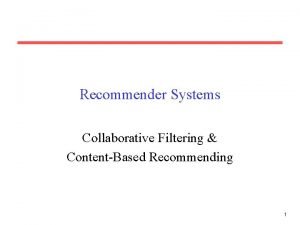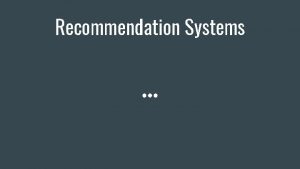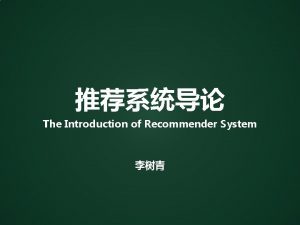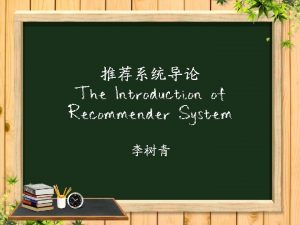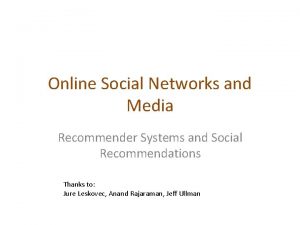Recommender Systems with Social Regularization And Some Critical



























- Slides: 27

Recommender Systems with Social Regularization And Some Critical Thinking Hao Ma, Dengyong Zhou, Chao Liu Microsoft Research Michael R. Lyu The Chinese University of Hong Kong Irwin King AT&T Labs – Research The Chinese University of Hong Kong Ting Chen Northeastern University

Recommender Systems are Everywhere 2

Web 2. 0 Web Sites are Everywhere 3

Trust-aware Recommender Systems • These Methods utilize the inferred implicit or observed explicit trust information to further improve traditional recommender systems. – [J. O’Donovan and B. Smyth, IUI 2005] – [P. Massa and P. Avesani, Rec. Sys 2007] – [H. Ma, I. King, and M. R. Lyu, SIGIR 2009] • Based on the motivation that “I trust you => I have similar tastes with you”. 4

Comparison • Trust-aware • Social-based – Trust network: unilateral relations – Social friend network: mutual relations – Trust relations can be treated as “similar” relations – Friends are very diverse, and may have different tastes – Few datasets available on the Web – Lots of Web sites have social network implementation 5

Contents of This Work • Focusing on social-based recommendation problems • Two methods are proposed based on matrix factorization with social regularization terms – Can be applied to trust-aware recommender systems. • Experiments on two large datasets – Douban (social friend network) – Epinions (trust network) 6

Problem Definition Social Network Information User-Item Rating Matrix 7

Low-Rank Matrix Factorization for Collaborative Filtering • Objective function Ui , Vj : low dimension column vectors to represent user/item preferences. 8

Social Regularization I • Average-based regularization Minimize Ui’s taste with the average tastes of Ui’s friends. The similarity function Sim(i, f) allows the social regularization term to treat users’ friends differently. 9

Social Regularization I • Gradients 10

Social Regularization II • Individual-based regularization This approach allows similarity of friends’ tastes to be individually considered. It also indirectly models the propagation of tastes. 11

Social Regularization II • Gradients 12

Similarity Function • Vector Space Similarity (VSS) or Cosine Similarity • Pearson Correlation Coefficient (PCC) 13

Dataset I • Douban – Chinese Web 2. 0 Web site with social friend network service – The largest online book, movie and music review and rating site in China – We crawled 129, 940 users and 58, 541 movies with 16, 830, 839 movie ratings – The total number of friend links between users is 1, 692, 952 14

Dataset II • Epinions – A well-known English general consumer review and rating site – Every member maintains a trust list which presents a user network of trust relationships – We crawled 51, 670 users who have rated a total of 83, 509 different items. The total number of ratings is 631, 064 – The total number of issued trust statements is 511, 799 15

Metrics • MAE and RMSE 16

Performance Comparison 17

Impact of Parameter beta 18

Impact of Similarity Functions 19

Conclusions • We proposed two new social recommendation methods • Our approaches perform better than other traditional and trust-aware recommendation methods • The methods scale well since the employed algorithm is linear with the observation of ratings 20

Future Work • Employ more accurate similarity functions • Consider item side regularization • Apply similar techniques to other social applications, like social search problems 21

Question I • What are the model assumptions? – Objective = Model Loss + Graph Smoothing – Graph quality is important, informally: • Contain “model-orthogonal” information • Graph structure: well-poor, poor-poor • Link weights reflect real similarity with relatively small variance – Graph constructed by social relation with VSS and PCC 22

Question I • What are the model assumptions? Then what role does social graph play here? – Social graph is not a similarity graph! Hao Ma, On Measuring Social Friend Interest Similarities in Recommender Systems. SIGIR 2014. 23

Question II • How different are average-based and individual-based regularization? Average-based Individual-based – If user i’s neighbors are fixed, take gradient w. r. t. U_i, two methods yield to the same optimum: 24

Question II • How different are average-based and individual-based regularization? – In the paper, the authors claimed for averagebased regularization: – Are these differences really exist between two regularization methods? 25

Question III • Global bias issue effect. – PMF assumes zero mean – Without bias, “zero mean” is not valid – Not presented in paper anywhere I can find it. 26

Thanks!
 Critical semi critical and non critical instruments
Critical semi critical and non critical instruments Critical semi critical and non critical instruments
Critical semi critical and non critical instruments Introduction to recommender systems
Introduction to recommender systems Recommender systems an introduction
Recommender systems an introduction Weighted hybrid recommender systems
Weighted hybrid recommender systems Cutout regularization
Cutout regularization Andrew ng regularization
Andrew ng regularization Graph laplacian regularization
Graph laplacian regularization Nn regularization
Nn regularization Latent factors recommender system
Latent factors recommender system Recommender relationship
Recommender relationship Contact and noncontact forces
Contact and noncontact forces Some trust in chariots and some in horses song
Some trust in chariots and some in horses song Critical reading meaning
Critical reading meaning They say it only takes a little faith
They say it only takes a little faith Sometimes you win some sometimes you lose some
Sometimes you win some sometimes you lose some Ice cream countable and uncountable nouns
Ice cream countable and uncountable nouns Fire and ice diamante poem
Fire and ice diamante poem Some say the world will end in fire some say in ice
Some say the world will end in fire some say in ice Apa itu social thinking
Apa itu social thinking Social thinking social influence social relations
Social thinking social influence social relations Decision support systems and intelligent systems
Decision support systems and intelligent systems Weather model of reflection maclean
Weather model of reflection maclean Compare and contrast social darwinism and social gospel
Compare and contrast social darwinism and social gospel Ethical and social issues in information systems
Ethical and social issues in information systems Ethical and social issues in information systems doc
Ethical and social issues in information systems doc Pincus and minahan
Pincus and minahan Chapter 4 ethical and social issues in information systems
Chapter 4 ethical and social issues in information systems



